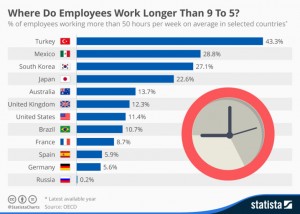Recruiters and hiring managers are like peanut butter and jelly, except when the peanut butter wishes the jelly would have told her about that Master’s requirement before she posted the job.
Okay so the analogy falls apart a little bit, but the fact remains that recruiters and hiring managers would, in an ideal world, work in tandem to find and keep the very best hires. In order to find the best people to fill a role, recruiters need to tap into hiring managers’ knowledge and expertise, and for hiring managers to be able to keep holding down the fort and moving their team forward, they need recruiters to listen when they are forthcoming with information.
In today’s global economy with a distributed workforce, this can be more difficult than ever before. While we have technology that allows us to communicate faster, (and 90% of the population using that technology) we also have barriers like time zones, endless meetings and the misunderstandings that can come from intake meetings that don’t always get to be face-to-face.
However, there are steps you can take to make sure you are successful in working with your hiring managers so you can get them the talent they need to keep their departments (and the company) running.
1. Meet with hiring managers often to understand how new hires are performing and their needs for new roles
This seems like it will add more to your plate, not less. But truthfully, when you speak to your hiring managers, you have lots to say. Ask about how their most recent hire is doing, inquire about engagement levels on their team. And most importantly, ask them to encourage their top performers and engaged team members to leave a review.
Underscore how important positive reviews about the company are on LinkedIn, Glassdoor and Ratedly. Many candidates look to crowdsourced sites to determine whether or not they want to work for your company. 69% of job seekers would not take a job with a company that has a bad reputation, even if the seeker is unemployed. Urging your hiring managers to send out a monthly review request is good for you AND good for them.
What you should do: Get in the habit of sending a monthly email to your hiring managers asking about new hires and reminding them to encourage their team members to review your company.
In addition, Revamp your intake process with candidates in mind. You’re the recruiter and you know what candidates ask you, so ask hiring managers the same questions. Smart, passive candidates are likely to ask why the role is empty, what the team environment is like and what they will spend their days doing. Go ahead and get this information from the hiring manager ahead of time. Asking specific questions about skill level, daily activities, team members and any specific background information will make recruiting for the empty role much easier.
If you haven’t already, create an intake form with specific questions like:
- What kind of skills does a person who is successful in this role need?
- What is the background of your ideal candidate? What sort of jobs might they have held before?
- What is the current team dynamic? What personalities thrive there?
- Why is the role empty? Is it due to growth or did someone leave?
2. Do research to understand the roles you are hiring for and what skills are actually required
Great recruiters are always trying to learn more. In fact, listening and communication skills are the top qualities of any recruiter. If you haven’t taken the time to research the position as soon as the req lands on your desk, don’t be angry with the hiring manager when they get frustrated having to tell you rudimentary keywords to search. How do you do this? By reading industry blogs, looking through profiles on professional websites and taking a look at the last couple of projects completed by the hiring team.
What you should do: Look over similar roles across the country. Find out what frequently occurring terms mean and bring your newly minted glossary with you to ensure you understand what those terms mean at your company.
Figure out what is actually required. And move the rest to a box to the left. Just kidding! But it is important to differentiate between what the hiring team wants and what they actually need. A common desire is to try to replace all the skills of the person who just left and/or to try and fill all the deficiencies of the current team with one hire. This is a fool’s errand for many recruiters and wastes time and money.
Ask questions about each requirement like:
- Does everyone on the current team have an MBA? Why do you feel that’s important?
- Did the last successful hire have an intermediate knowledge of Ruby on Rails? Could we train a beginner if necessary?
- Does this person have to work from 7-4 simply because the rest of the team does? Will a split shift or later sign on cause harm to the team?
For every need, determine a probing question so you can widen the talent funnel and focus on as many great candidates as possible.
3. Set expectations and make sure they understand the hiring timeline
Before working on a new requirement with a hiring manager, take a step back and swallow an empathy pill. Recruiters tend to work well under pressure, but that’s not always true of everyone. Consider that until this role is filled, the hiring manager you’re about to meet with will be doing the work of two people and managing a team who is also chipping in to make sure the work gets done. If you attempted to separate needs from wants and got pushback, this may be why.
So, arm yourself with data. Show the hiring manager how much more quickly you might be able to fill the role if they were willing to train someone on QuickBooks versus hiring an expert. Show them how many project managers are available in your region who are not Six Sigma certified…yet.
What you should do: Let hiring managers know how long you anticipate the search to take depending on the final list of requirements. If possible, print out screenshots of the criteria you have before this conversation to show the difference between the timeline for a PMP Ninja and someone re-entering the workforce whose credentials expired.
4. Be accountable and expect accountability in return
Make it as easy as possible for hiring managers to give you feedback. Record it in the ATS, send an email, walk to their desk with a tape recorder in your hand if you have to, but get their feedback or you will be in bottleneck purgatory. Set an ideal timeline for every step and get their agreement before setting off to fill the role. Let your hiring manager know in no uncertain terms their inability to meet these deadlines will result in that role staying open even longer…no one wants that!
What you should do: Again, your data tells a story, so look to see what this manager’s timelines normally look like. If they are a two-week Timmy, you are not going to turn them into a four-day Frank overnight. Set reasonable deadlines they can actually hit. The average new hire takes 27 business days, an all-time high. So, as long as you both work to cut that number down, you should be on good deadline terms. But there are other things to consider. Does your data show the hiring manager is responsive and you’re the deadlock? Well, that’s a whole other article.
Have more tips you’ve found succeed when working with your hiring manager? Share with me!
Business & Finance Articles on Business 2 Community(64)
Report Post






